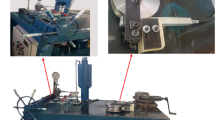Abstract
The hydro-bending process of a double-layered tube is an effective approach for the manufacture of large-diameter, ultra thin-walled curved tubes. The hydro-bending of a mild/stainless steel double-layered tube is investigated here using numerical simulation and experiments. The thickness distribution of the inner tube is investigated in depth through a combination of numerical simulation and theoretical analysis. We found that maximum thinning occurred not at the center of the outer arc but at a nearby point and the maximum thinning ratio of the outer arc was 14.3 %. The reason the maximum thickness reduction occurred at a nearby point rather than the center point of the outer arc was well illustrated and was that the point with the biggest axial stress moved towards the tube ends. The analysis provides further theoretical foundation for the hydro-bending process of ultra thin-walled components.
Similar content being viewed by others
References
Mathon C, Limam A (2006) Experimental collapse of thin cylindrical shells submitted to internal pressure and pure bending. Thin-Walled Struct 44:39–50
Chitawadagi MV, Narasimhan MC (2009) Strength deformation behaviour of circular concrete filled steel tubes subjected to pure bending. J Constr Steel Res 65:1836–1845
Li H, Yang H, Yan J, Zhan M (2009) Numerical study on deformation behaviors of thin-walled tube NC bending with large diameter and small bending radius. Comput Mater Sci 45:921–934
Li H, Yang H, Zhan M, Kou YL (2010) Deformation behaviors of thin-walled tube in rotary draw bending under push assistant loading conditions. J Mater Process Technol 210:143–158
Yang H, Yan J, Zhan M, Li H, Kou YL (2009) 3D numerical study on wrinkling characteristics in NC bending of aluminum alloy thin-walled tubes with large diameters under multi-die constraints. Comput Mater Sci 45:1052–1067
Chen JS, Daxin E, Zhang JW (2013) Effects of process parameters on wrinkling of thin-walled circular tube under rotary draw bending. Int J Adv Manuf Technol 68:1505–1516
Al-Qureshi HA (1999) Elastic–plastic analysis of tube bending. Int J Mach Tools Manuf 39:87–104
Kami A, Dariani BM (2011) Prediction of wrinkling in thin-walled tube push-bending process using artificial neural network and finite element method. Proc IMechE B J Eng Manuf 225:1801–1812
Miller JE, Kyriakides S, Bastard AH (2001) On bend-stretch forming of aluminum extruded tubes I: experiments. Int J Mech Sci 43:1283–1317
Miller JE, Kyriakides S, Corona E (2001) On bend-stretch forming of aluminum extruded tubes II: analysis. Int J Mech Sci 43:1319–1338
Corona E (2004) A simple analysis for bend-stretch forming of aluminum extrusions. Int J Mech Sci 46:433–448
Li H, Yang H, Xu J, Liu H, Wang D, Li GJ (2013) Knowledge-based substep deterministic optimization of large diameter thin-walled Al-alloy tube bending. Int J Adv Manuf Technol 68:1989–2004
Daxin E, Li RT (2014) Influence of additional tensile force on the stress and deformation of numerically controlled tube bending. Int J Adv Manuf Technol. doi:10.1007/s00170-014-6675-9
Lovric M (2010) Press-bending of thin-walled tubes/increasing the productivity of internal high pressure forming processes. In:Liewald M (ed) Proceedings of the 4th international conference on hydroforming (MAT-INFO, Frankfurt). Fellbach, Germany:365–386
Wang XS, Song P, Zhao ZY, Yuan SJ (2011) Influence of tube ends constraint on hydro-bending of thin-walled aluminum tube. Trans Nonferrous Metals Soc China 21:s440–s444
Lazarescu L (2013) Effect of internal fluid pressure on quality of aluminum alloy tube in rotary draw bending. Int J Adv Manuf Technol 64:85–91
Yuan SJ, He ZB, Liu G (2012) New developments of hydroforming in China. Mater Trans 53(5):787–795
Hu L, Teng BG, Yuan SJ (2012) Effect of internal pressure on hydro bending of bi-layered tube. Proc IMechE B J Eng Manuf 226(10):1717–1726
Teng BG, Hu L, Yuan SJ (2013) Deformation of thin-walled tube bending with internal pressure. Rev Adv Mater Sci 33:436–441
Xie WC, Teng BG, Yuan SJ (2015) Deformation analysis of hydro-bending of bi-layered metal tubes. Int J Adv Manuf Technol. doi:10.1007/s00170-014-6675-9
Author information
Authors and Affiliations
Corresponding author
Rights and permissions
About this article
Cite this article
Wang, X., Li, F. Analysis of wall thickness variation in the hydro-bending of a double-layered tube. Int J Adv Manuf Technol 81, 67–72 (2015). https://doi.org/10.1007/s00170-015-7188-x
Received:
Accepted:
Published:
Issue Date:
DOI: https://doi.org/10.1007/s00170-015-7188-x



